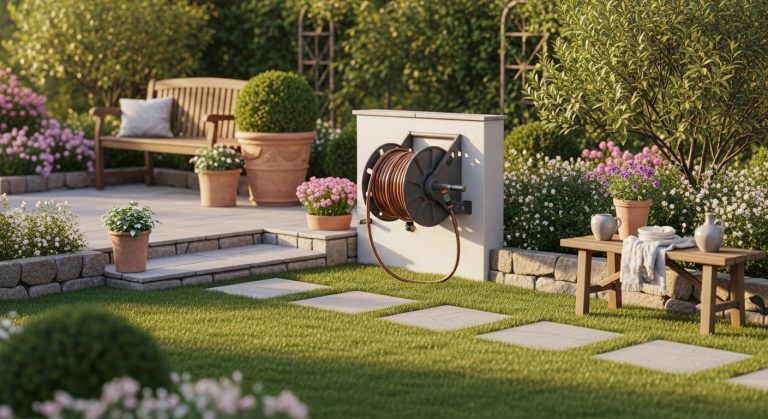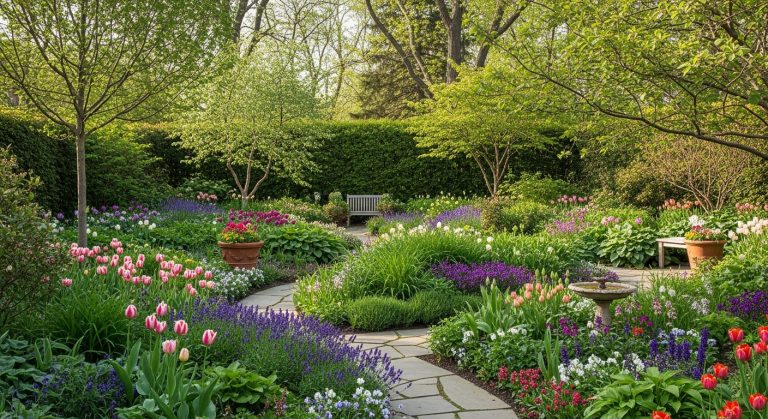Curved Garden Design: 15 Creative Ways to Bring Flow and Elegance to Your Outdoor Space
Have you ever looked at your garden and thought, “It’s fine, but it’s just… flat”? Same here. I’ve been there—walking along straight edging, corners everywhere, feeling like I’m in a grid instead of a garden. That’s when I discovered the power of curved garden design. Suddenly everything softened, the eye wandered, and the space felt bigger and more relaxed.
Curved borders can make gardens feel both larger and more private. So if you’re ready to escape the boxy garden look and give your outdoor space some flow, this article is for you. I’ll walk you through 15 unique ideas for curved garden design—each one practical, playful, and full of personality.
1. Sweeping Border Beds with Generous Arcs

Imagine a bed that curves gracefully around your lawn, hugging the shape of your home or a patio. That kind of curved garden design feels expansive and soft—way more inviting than sharp corners.
Pros:
- Creates movement: The eye follows the curve, making the space feel larger.
- Softens angles: It tempers the hard lines of fences, walls, or buildings.
- Natural feel: Mimics the gentle curves found in nature.
Cons:
- Installation complexity: Drawing a smooth, accurate curve takes time.
- Maintenance required: Keeping a smooth edge along a curve can be tricky.
Takeaway:
If you’re ready to turn your garden into something more organic, sweeping curved beds are a top-notch starting point.
2. Winding Pathways that Lead the Eye

Straight paths might get you from A to B, but a gently curving one invites a slow stroll and a sense of discovery. In curved garden design, paths aren’t just functional—they’re part of the experience.
Pros:
- Adds intrigue: You don’t see everything at once—there’s always a surprise around the bend.
- Encourages meandering: Ideal for gardens where you want relaxation, not just transit.
- Breaks monotony: Helps narrow or rectangular gardens feel less boxy.
Cons:
- Space-intensive: Curves can take up more ground than straight lines.
- Practical risks: People (and pets!) often cut across the shortest route if the design isn’t defined well.
Takeaway:
Swap one straight walkway for a winding curve and your garden gains depth, character, and purpose.
3. Raised Curved Beds for Height and Drama
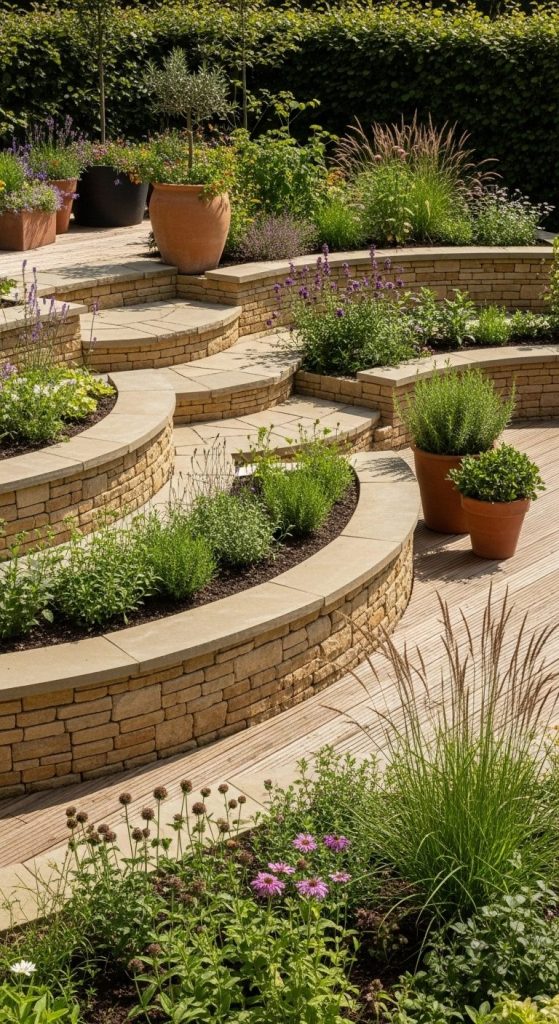
Installing raised beds that follow a curved line instantly adds structure and luxury. If you want your curved garden design to feel upscale and intentional, this is your move.
Pros:
- Improved drainage and soil: Raised beds often perform better than in-ground beds.
- Visual prominence: Curves elevated above ground stand out as design features.
- Design versatility: You can layer plants front to back for maximum impact.
Cons:
- Cost and labor: Building raised, curved walls or frames takes effort and budget.
- Irrigation concerns: Raised soil tends to dry faster.
Takeaway:
If you have the budget and want a showy, structured look, raised curved beds deliver big.
4. Curved Planting Around Circular Patio or Pond

Got a circular patio or a round pond? Use a curved planting layout around it to tie everything together beautifully.
Pros:
- Harmonious shapes: Round features combined with sweeping curves feel unified.
- Focal point: A curved planting around a circle draws attention and invites relaxation.
- Enhanced flow: You naturally move around the circle and curve, enjoying more of the garden.
Cons:
- Complex installation: Aligning the curve with circular features needs precision.
- Visual heaviness: If overdone, the curve may dominate too much.
Takeaway:
Integrate your round hardscaping with complementary curves in planting for a cohesive and intentional look.
5. Curve-Edged Grass or Lawn Beds

Instead of a rectangular lawn, why not shape your grass edges into rippling curves that flow into planting beds?
Pros:
- Soft transitions: Lawn to bed blends gently, not abruptly.
- Visual interest: Curved lawns feel more relaxed and natural.
- Better integration: Plantings push into the grass in a welcoming, organic way.
Cons:
- Mowing challenge: Curves may require more time or specialized mowing techniques.
- Edge maintenance: The curved edge will need trimming to stay crisp.
Takeaway:
Turn at least one lawn edge into a gentle curve—it transforms a plain yard into something eye-catching.
6. Curved Seating Walls or Benches

A built-in bench that curves around a tree, pond, or fire pit adds comfort and style. In curved garden design, hardscape curves provide both function and form.
Pros:
- Inviting shape: Round seating encourages gathering and conversation.
- Design statement: A curved bench becomes a focal piece.
- Supports planting: It gives a backdrop for lush curved plantings.
Cons:
- Requires craftsmanship: Curved structures cost more than straight ones.
- Balance needed: Overly large seating can overpower plantings.
Takeaway:
Pair a curved seating area with sweeping beds to create a social, elegant outdoor space.
7. Layered Curved Beds of Differing Heights
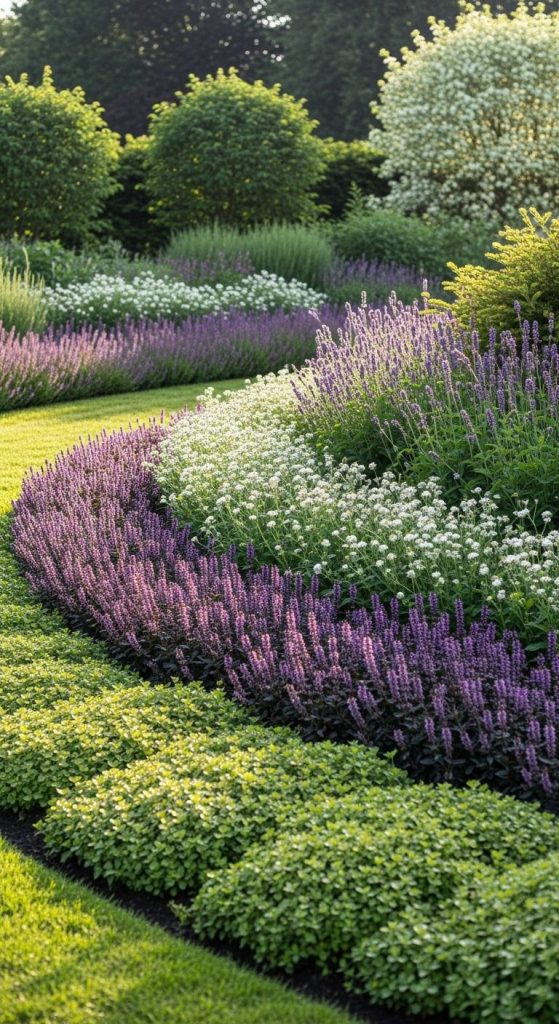
Imagine three concentric arcs of planting: low ground cover, mid-height perennials, and taller shrubs behind. That’s curved garden design with depth and character.
Pros:
- Rich layering: Height variation keeps the eye moving.
- Seasonal interest: Each layer can have its own bloom time or texture.
- Natural drama: Curves and layers together feel lush and immersive.
Cons:
- Complex planning: Requires coordination of heights, bloom times, and spacing.
- Maintenance load: More layers mean more upkeep.
Takeaway:
For a garden that reads like a landscape painting, layered curved beds are a must-try.
8. Curved Vertical Features: Arches, Pergolas, Trellises
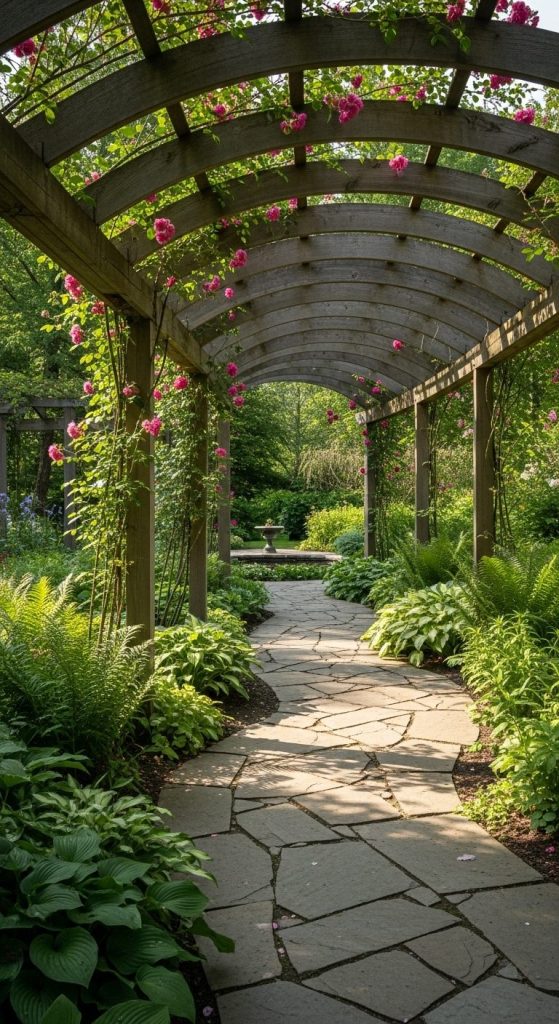
Why keep curves only on the ground? Introduce arched vertical elements to carry the design upward.
Pros:
- Guides the gaze upward: Adds height and structure.
- Supports climbers: Vines and roses follow the curve beautifully.
- Creates transitions: A curved pergola signals a shift between garden zones.
Cons:
- Structural care: Curved designs need proper support.
- Higher cost: More complex shapes require skilled craftsmanship.
Takeaway:
Extend your curves skyward—curved arches and pergolas make your garden feel immersive.
9. Curved Garden Borders in Tight or Narrow Spaces
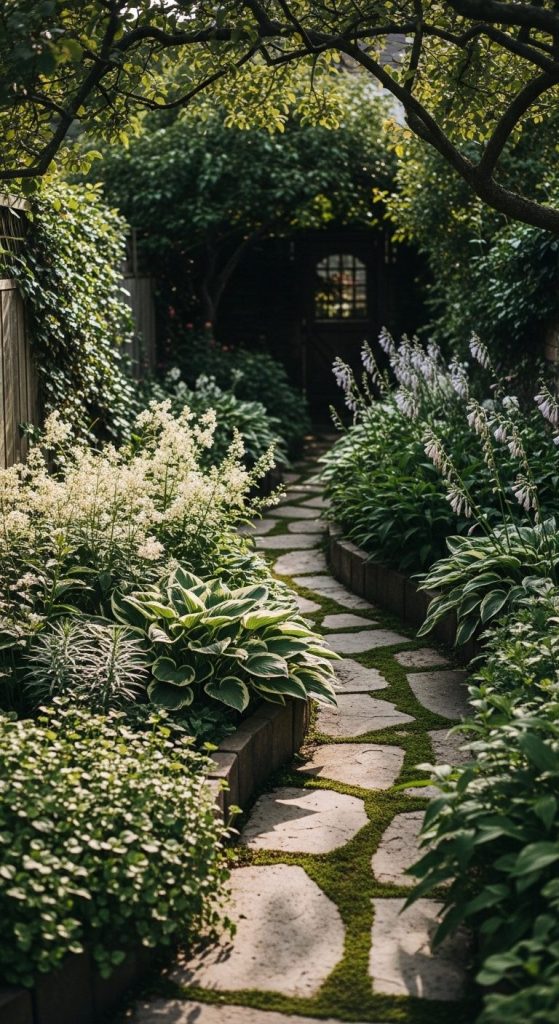
Even in narrow gardens, gentle curves create softness and space illusion. Avoiding straight lines helps the area feel wider and more natural.
Pros:
- Illusion of space: Curves break the tunnel effect.
- Flexibility: Curves wrap around awkward corners or obstacles.
- Quick impact: A single curve can transform a small yard.
Cons:
- Limited impact: In very small spaces, the effect may be subtle.
- Maintenance: Tight areas make curved edges harder to trim.
Takeaway:
Even one curve can make a compact garden feel open and free-flowing.
10. Curving Edges for Water Features and Ponds
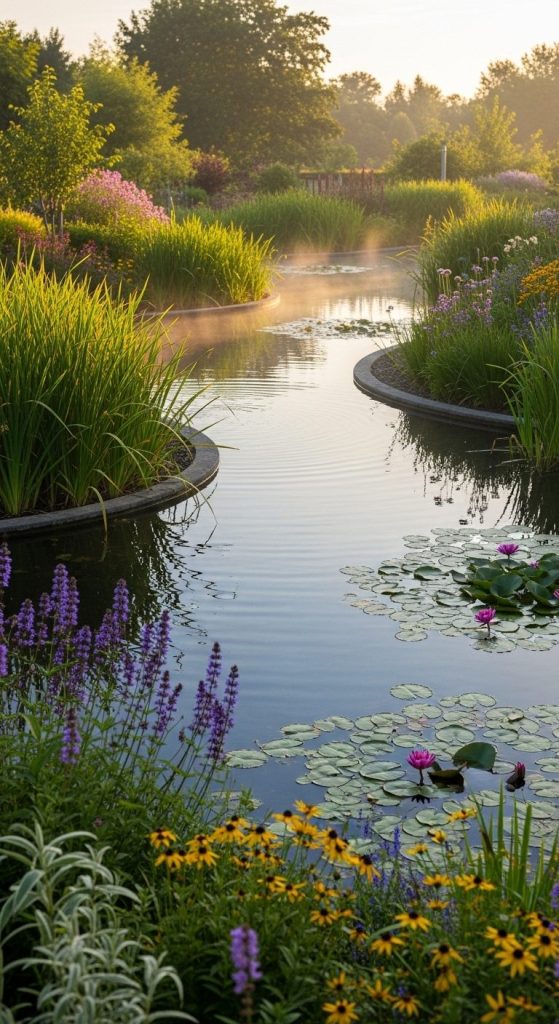
Ponds and water features with sharp corners look unnatural. Soft curves create a more organic, calming presence.
Pros:
- Natural look: Mimics rippling shapes in nature.
- Better integration: Plantings blend smoothly into the waterline.
- Visual calm: Curves enhance serenity and balance.
Cons:
- Technical skill: Curved ponds require careful construction.
- Maintenance: Cleaning around curves can be tricky.
Takeaway:
If you love tranquil water features, embrace curves for a seamless, peaceful design.
11. Multi-Level Terraced Curves on Slopes
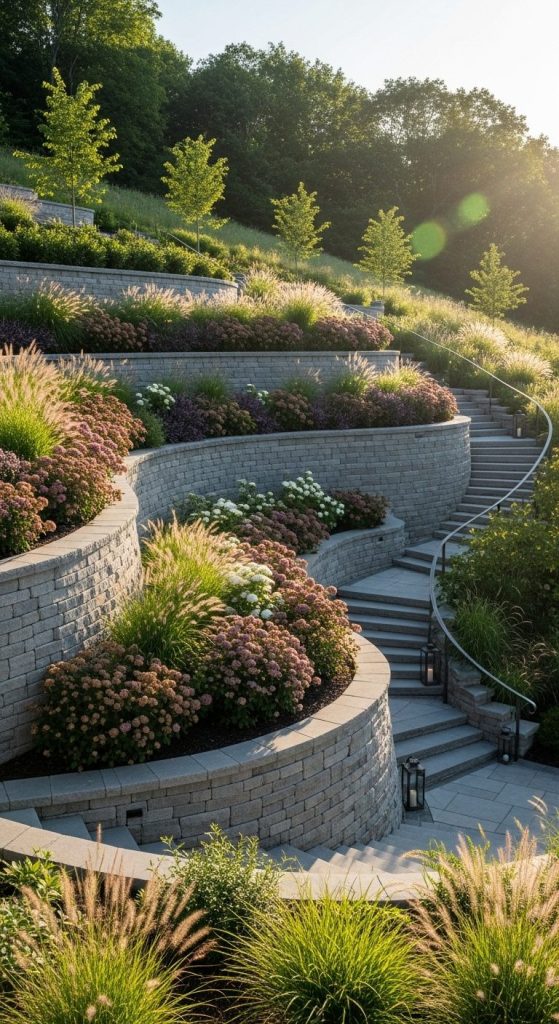
Curves on slopes or terraces can transform challenging terrain into artful garden layers.
Pros:
- Erosion control: Curved terraces manage runoff beautifully.
- Visual drama: Layers of curves on a slope are eye-catching.
- Functional zoning: Each level can serve a different purpose.
Cons:
- Engineering cost: Proper drainage and structure are essential.
- Access issues: More levels mean more upkeep.
Takeaway:
Instead of fighting a slope, let curves shape it—your hillside becomes a masterpiece.
12. Curved Planting That Echoes Architectural Lines
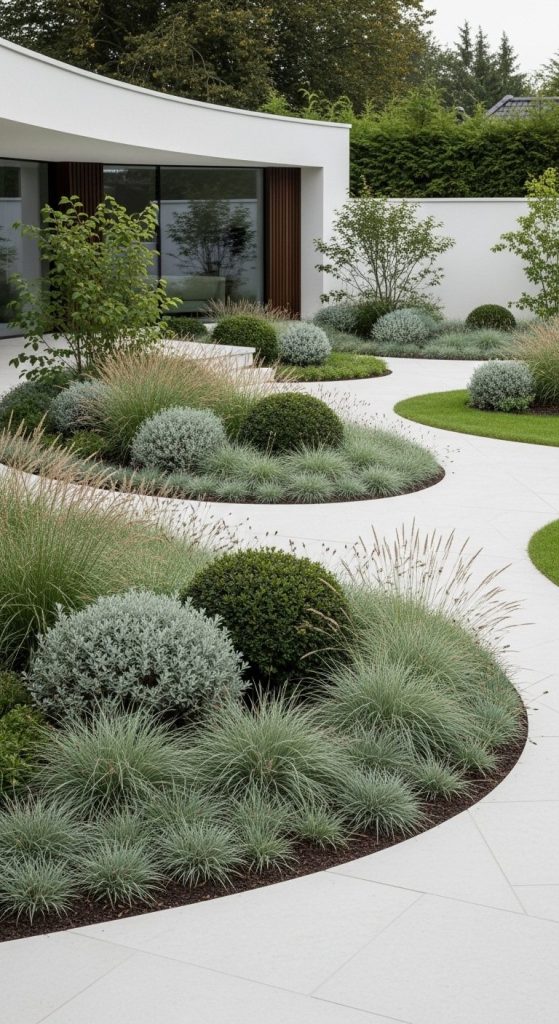
Match or contrast your home’s lines for harmony and sophistication.
Pros:
- Cohesive design: The garden feels connected to the house.
- Visual balance: Curves can soften sharp architecture.
- Refined look: Adds flow between built and natural elements.
Cons:
- Over-design risk: Too many mirrored shapes can look forced.
- Style mismatch: Requires careful planning with modern architecture.
Takeaway:
Let your home’s shape guide your curves—it’s the secret to balanced garden design.
13. Curved Edging Materials and Hardscape
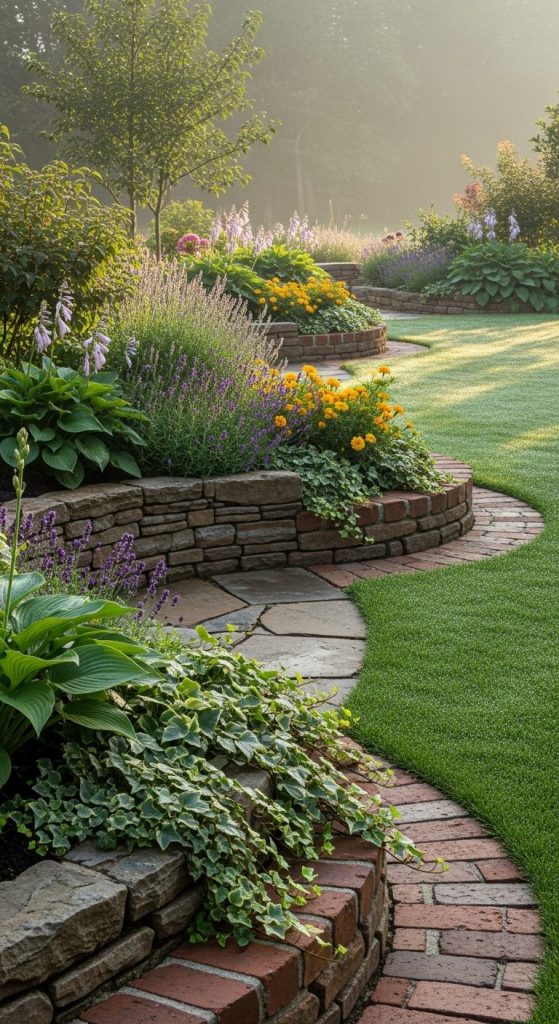
Curved edges need the right materials to look polished and lasting.
Pros:
- Defined shape: Good edging highlights the curve.
- Material variety: Stone, brick, metal—all suit curves.
- Durability: Keeps mulch, grass, and soil in place.
Cons:
- Installation precision: Poorly aligned edges ruin the effect.
- Cost: High-quality materials add up.
Takeaway:
Your edging is what defines the curve—invest in quality materials for clean, lasting lines.
14. Curved Garden Zones: Creating ‘Rooms’ with Flow
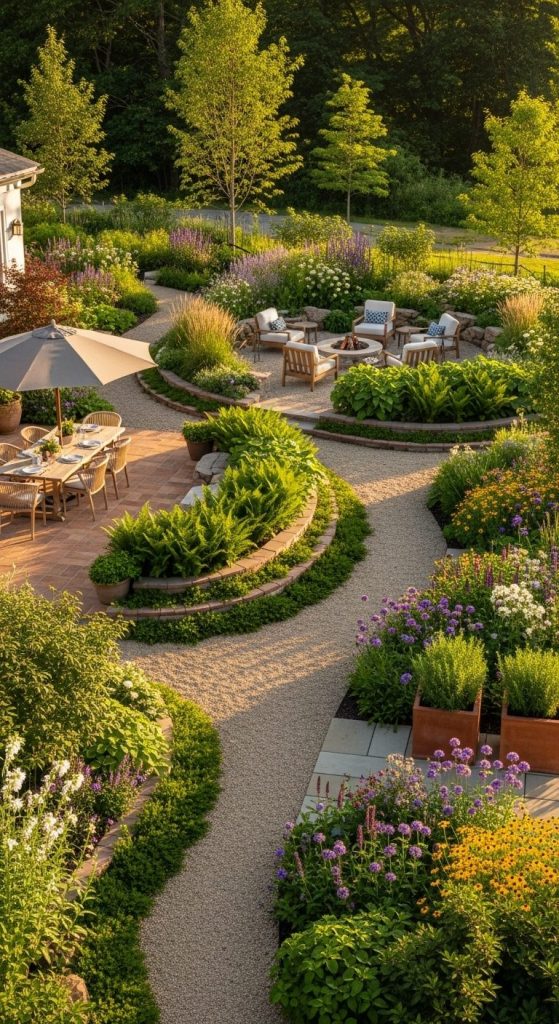
Use curves to define spaces without hard divisions—lounging, dining, or play.
Pros:
- Functional clarity: Each zone feels distinct but connected.
- Visual rhythm: Curves guide the eye from area to area.
- Adaptable: Change use over time without major redesign.
Cons:
- Complex planning: Balancing flow between zones takes thought.
- Practicality: Hard surfaces must match traffic flow.
Takeaway:
Curves bring flexibility and flow—turn your yard into a series of connected garden “rooms.”
15. Curved Garden Design for Sustainability and Wildlife

Curves don’t just look good—they work with nature.
Pros:
- Wildlife friendly: Flowing beds encourage pollinators and birds.
- Stress reduction: Natural shapes are proven to calm the mind.
- Efficient use of space: Irregular beds adapt to terrain naturally.
Cons:
- Learning curve: Sustainable planting takes planning.
- Less formal look: Wild edges may feel untidy to some.
Takeaway:
Design with intention—curves can make your garden both beautiful and eco-friendly.
Conclusion
There you have it—15 inspiring ways to master curved garden design. Whether your space is tiny or sprawling, curves bring a relaxed rhythm that’s impossible to fake. My favorite? A winding path that leads to a curved seating nook—feels like your own little world.
The key? Don’t force the curve. Let your space, your home, and your instincts shape it. When you do, you’ll create a garden that feels natural, welcoming, and uniquely yours.

William Martin is a passionate bowler who spends most of his weekends playing the sport. With years of intense experience under his belt, William decided to share his knowledge by creating BOWLING OCEAN. Join me on this journey to explore the world of bowling and discover the tips and tricks to becoming a pro.


